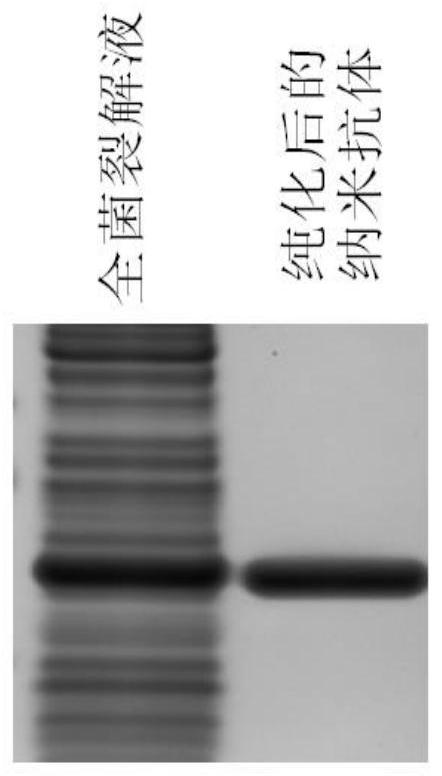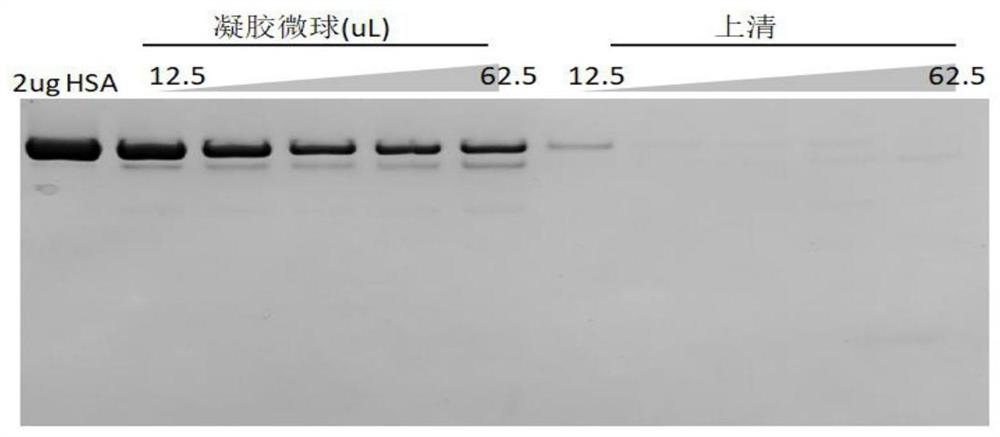Human Serum Albumin Removal Kit
A technology of human serum albumin and kits, which is applied in the direction of biological testing, preparation of test samples, material inspection products, etc. It can solve the problems that protein components cannot be detected, limit the application of biological mass spectrometry, and albumin occupies analysis capacity, etc. , to achieve the effects of stable properties, wide range of applications, and easy preparation
- Summary
- Abstract
- Description
- Claims
- Application Information
AI Technical Summary
Problems solved by technology
Method used
Image
Examples
Embodiment 1
[0017] Embodiment 1, the preparation of anti-human serum albumin nanobody
[0018] (1) Synthesize the nucleic acid molecule encoding the above-mentioned anti-human serum albumin nanobody according to the sequence shown in the above-mentioned SEQ ID NO.2. Simultaneously, at the 5' end of the nucleic acid molecule, an Nde I restriction site (CATATG) is added, and a Not I restriction site (GCGGCCGC) is added at the 3' end.
[0019] (2) Use the pET30a(+) prokaryotic expression plasmid as the nanobody expression vector. The expression vector and the nucleic acid molecular fragments of the above-mentioned nanobodies were digested with Not I and Nde I enzymes. The digestion conditions were: 1 μg of DNA, 5 μL of 10X buffer, 1 μL of Not I and Nde I enzymes, added water to 50 μL, and 37°C After 20 minutes in water bath, inactivate at 80°C for 10 minutes, and recover the fragments after running the gel.
[0020] (3) Carrier and fragment ligation: 50 μg of carrier, 40 μg of fragment, 1 ...
Embodiment 2
[0027] Embodiment 2, the preparation of immunoaffinity material
[0028] (1) Take 2 mg of purified anti-human serum albumin nanobody, and make it into 1 mg / mL with cross-linking buffer;
[0029] (2) Get 0.3 mg of cyanogen bromide-activated agarose and soak it in 0.1M hydrochloric acid for 20 minutes to make cyanogen bromide-activated agarose microspheres;
[0030] (3) Wash the cyanogen bromide-activated agarose gel microspheres 3 times with cross-linking buffer, mix the nanobody solution with the gel microspheres, and incubate with shaking at room temperature for 2 hours;
[0031] (4) Alternately washing the cyanogen bromide-activated sepharose microspheres with cross-linking buffer and low pH acetic acid solution for 3 times;
[0032] (5) Resuspend the cyanogen bromide-activated sepharose microspheres in 1 mL of PBS and store at 4°C for later use.
Embodiment 3
[0033] Embodiment 3, the mensuration of immunoaffinity material adsorption capacity
[0034] (1) Dilute 25 μg of human serum albumin into 50 μg of PBS buffer, and prepare 5 copies in total;
[0035] (2) Take 12.5 μL, 25 μL, 37.5 μL, 50 μL, and 62.5 μL of cyanogen bromide-activated agarose gel microspheres, mix them with human serum albumin diluent, and incubate with shaking at room temperature for 20 minutes;
[0036] (3) Centrifuge at 100g room temperature for 2 minutes, and take the supernatant;
[0037] (4) Take 4 μL supernatant and 1 μL agarose gel microspheres, run SDS-PAGE gel electrophoresis, the result is as follows figure 2 As shown in the figure, the loading volume of the gel microspheres is 0.5uL, and the loading volume of the supernatant is 4uL;
[0038] (5) Calculate the capacity of 1 μL of cyanogen bromide-activated agarose gel microspheres to adsorb human serum albumin as 2 μg.
PUM
 Login to View More
Login to View More Abstract
Description
Claims
Application Information
 Login to View More
Login to View More - R&D
- Intellectual Property
- Life Sciences
- Materials
- Tech Scout
- Unparalleled Data Quality
- Higher Quality Content
- 60% Fewer Hallucinations
Browse by: Latest US Patents, China's latest patents, Technical Efficacy Thesaurus, Application Domain, Technology Topic, Popular Technical Reports.
© 2025 PatSnap. All rights reserved.Legal|Privacy policy|Modern Slavery Act Transparency Statement|Sitemap|About US| Contact US: help@patsnap.com



